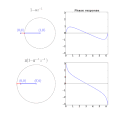Minimum_and_maximum_phase_responses.gif (450 × 450 pixels, file size: 573 KB, MIME type: image/gif, looped, 55 frames, 2.8 s)
| This is a file from the Wikimedia Commons. Information from its description page there is shown below. Commons is a freely licensed media file repository. You can help. |
Summary
| DescriptionMinimum and maximum phase responses.gif |
English: Shows the phase responses of a minimum and maximum phase responses when  is a monomial with is a monomial with  . Both filters have the same gain response. Top : Minimum phase filter. Bottom : Maximum phase filter. Left : Nyquist diagram. Right : Phase responses . Both filters have the same gain response. Top : Minimum phase filter. Bottom : Maximum phase filter. Left : Nyquist diagram. Right : Phase responses |
| Date | |
| Source | Own work |
| Author | fdeloche |
Licensing
I, the copyright holder of this work, hereby publish it under the following license:
This file is licensed under the Creative Commons Attribution-Share Alike 4.0 International license.
- You are free:
- to share – to copy, distribute and transmit the work
- to remix – to adapt the work
- Under the following conditions:
- attribution – You must give appropriate credit, provide a link to the license, and indicate if changes were made. You may do so in any reasonable manner, but not in any way that suggests the licensor endorses you or your use.
- share alike – If you remix, transform, or build upon the material, you must distribute your contributions under the same or compatible license as the original.
Generation code
Minimumphase.py
# coding: utf-8
'''Generate an animation showing the phase response for a minimum and maximum phase system'''
__author__ = "fdeloche"
# In[1]:
get_ipython().magic(u'matplotlib inline')
import sys
import numpy as np
import matplotlib.pyplot as pl
from matplotlib.animation import FuncAnimation
# In[2]:
createGif=True
pl.rc('xtick', labelsize=20)
pl.rc('ytick', labelsize=20)
pl.rc('font', weight='bold')
# In[3]:
fig, ((ax1, ax2), (ax3, ax4)) = pl.subplots(2, 2, figsize=(15, 15))
#fig.set_tight_layout(True)
a_x = 0.8
a_y=0.
m=1000
A = a_x + 1j*a_y
a_mod = np.abs(A)
Ainv = 1./A
a_xbis = np.real(Ainv)
a_ybis = -np.imag(Ainv)
# r^2 =
x_lim_a = -0.3
x_lim_b = 1.9
y_lim = 1.1
t = np.linspace(0, 1, num=m)
ax1.scatter(0, 0, linewidth=6, color='blue')
ax1.scatter(1, 0, linewidth=4, color='blue')
ax1.set_xlim([x_lim_a, x_lim_b])
ax1.set_ylim([-y_lim, y_lim])
ax1.set_title('$1-az^{-1}$', fontsize=35)
ax1.plot(t, np.zeros(m), color='blue', linewidth=4)
ax1.plot(1+a_mod*np.cos(2*np.pi*t), a_mod*np.sin(2*np.pi*t), color='black')
ax1.axis('off')
ax1.text(-0.2, 0.1, "$(0, 0)$", fontsize=30, color='blue')
ax1.text(1-0.1, 0.1, "$(1, 0)$", fontsize=30, color='blue')
ax3.set_title('$\overline{a}(1-\overline{a}^{\ -1}z^{-1})$', fontsize=35)
ax3.scatter(0, 0, linewidth=6, color='blue')
ax3.scatter(np.abs(A), 0, linewidth=4, color='blue')
ax3.set_xlim([x_lim_a, x_lim_b])
ax3.set_ylim([-y_lim, y_lim])
ax3.plot(t*np.abs(A), np.zeros(m), color='blue', linewidth=4)
ax3.plot(np.abs(A)+np.cos(2*np.pi*t), np.sin(2*np.pi*t), color='black')
ax3.axis('off')
ax3.text(-0.1, 0.1, "$(0, 0)$", fontsize=30, color='blue')
ax3.text(-0.1+np.abs(A), 0.1, "$(\overline{a}, 0)$", fontsize=30, color='blue')
Z = np.cos(2*np.pi*t) - 1j*np.sin(2*np.pi*t)
G = np.angle(1-A*Z)
ax2.set_title('Phase response', fontsize=25)
ax2.plot(2*np.pi*t, G, color='blue', linewidth=2)
ax2.plot(2*np.pi*t, 0*t, color='black')
G2 = np.angle(1-np.conj(Ainv)*Z)
#ax4.set_title('Phase response', fontsize=25)
ax4.plot(2*np.pi*t, G2, color='blue', linewidth=2)
ax4.plot(2*np.pi*t, 0*t, color='black')
ax2.set_ylim([-np.pi, np.pi])
ax4.set_ylim([-np.pi, np.pi])
ax2.set_xlim([0, 6.283])
ax4.set_xlim([0, 6.283])
'''
ax2.spines["top"].set_visible(False)
ax2.spines["right"].set_visible(False)
ax4.spines["top"].set_visible(False)
ax4.spines["right"].set_visible(False)
'''
# In[4]:
line1, = ax1.plot(1-np.abs(A)*t*1, t*0, color='blue', linewidth=4)
line2, = ax3.plot(np.abs(A)-t*1, t*0, color='blue', linewidth=4)
line3, = ax1.plot((1-np.abs(A))*t*1, t*0, color='red', linewidth=4)
line4, = ax3.plot((np.abs(A)-1)*t, t*0, color='red', linewidth=4)
point1 = ax1.scatter(1-np.abs(A), 0, linewidth=5, color='red')
point2 = ax3.scatter(np.abs(A)-1, 0, linewidth=5, color='red')
line5, = ax2.plot(0*t, G[0]*t, color='red', linewidth=4)
line6, = ax4.plot(0*t, G2[0]*t, color='red', linewidth=4)
point3 = ax2.scatter(0, G[0], color='red', linewidth=5)
point4 = ax4.scatter(0, G2[0], color='red', linewidth=5)
# In[5]:
n_frames = 55
def update(i):
t0 = i*1./n_frames
B = [a_mod*np.cos(2*np.pi*t0), -a_mod*np.sin(2*np.pi*t0)]
line1.set_xdata(1-t*B[0])
line1.set_ydata(-t*B[1])
C = [np.cos(2*np.pi*t0), -np.sin(2*np.pi*t0)]
line2.set_xdata(np.abs(A)-t*C[0])
line2.set_ydata(-t*C[1])
line3.set_xdata((1-B[0])*t)
line3.set_ydata(-t*B[1])
line4.set_xdata((np.abs(A)-C[0])*t)
line4.set_ydata(-t*C[1])
point1.set_offsets((1-B[0], -B[1]))
point2.set_offsets((np.abs(A)-C[0], -C[1]))
line5.set_xdata(2*np.pi*t0+0*t)
line6.set_xdata(2*np.pi*t0+0*t)
Z0 = np.cos(2*np.pi*t0) - 1j*np.sin(2*np.pi*t0)
G0 = np.angle(1-A*Z0)
G20 = np.angle(1-np.conj(Ainv)*Z0)
line5.set_ydata(G0*t)
line6.set_ydata(G20*t)
point3.set_offsets((2*np.pi*t0, G0))
point4.set_offsets((2*np.pi*t0, G20))
return line1, line2, line3, line4, point1, point2, line5, line6, point3, point4
# In[ ]:
anim = FuncAnimation(fig, update, frames=np.arange(0,n_frames), interval=50, blit=True)
if(createGif):
anim.save('result.gif', dpi=30, writer='imagemagick')
else:
pl.show()
# In[ ]:
Captions
Add a one-line explanation of what this file represents
Items portrayed in this file
depicts
some value
21 September 2016
File history
Click on a date/time to view the file as it appeared at that time.
| Date/Time | Thumbnail | Dimensions | User | Comment | |
|---|---|---|---|---|---|
| current | 09:35, 21 September 2016 |  | 450 × 450 (573 KB) | Ixnay | User created page with UploadWizard |
File usage
The following page uses this file:
Global file usage
The following other wikis use this file:
- Usage on ca.wiki.x.io
- Usage on fr.wiki.x.io
- Usage on zh.wiki.x.io
